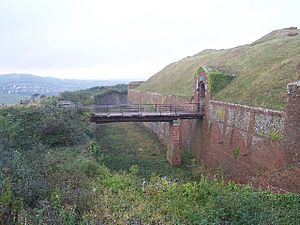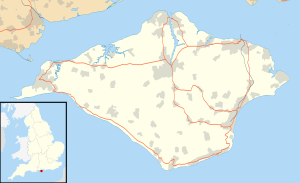Bembridge Fort facts for kids
Quick facts for kids Bembridge Fort |
|
|---|---|
| Bembridge Down, Isle of Wight, England | |

Bembridge Fort
|
|
| Coordinates | 50°40′18″N 1°07′03″W / 50.671673°N 1.117616°W |
| Site information | |
| Owner | National Trust |
| Open to the public |
By Appointment |
| Official name | Bembridge Fort |
| Designated | 17 March 1964 |
| Reference no. | 1012717 |
| Site history | |
| Built | July 1867 |
| Built by | British Army |
| Materials | Brick, Flint |
| Battles/wars | World War I World War II |
| Garrison information | |
| Garrison | 4 officers, 106 men |
Bembridge Fort is a historic building on the Isle of Wight, England. It sits on the highest point of Bembridge Down, near Bembridge village. This fort is one of many "Palmerston Forts." These forts were built around Portsmouth in the 1800s. They were made to protect Britain from a possible French invasion. At that time, people worried about Napoleon III of France.
The fort has a unique hexagonal shape. It was the main defense for the southeast coast of the Isle of Wight. It was also designed as a last safe place if the island was attacked. Its location gave it great views over Sandown Bay and the Eastern Solent. This made it the main control center for other forts on the Isle of Wight. These included Redcliff Battery, Yaverland Battery, Sandown Fort, and Sandown Barrack Battery. The fort could house 4 officers and 106 soldiers. It was originally armed with six large Armstrong guns.
The Fort's Story
Bembridge Fort has a long and interesting history. It played different roles over the years.
Building the Fort
- 1860s: A large stone monument, called The Yarborough Monument, was moved. It was taken from the top of Bembridge Down, stone by stone. This made room for the new fort to be built.
- 1862-1867: The fort was built. It cost about £48,925, which was a lot of money back then!
- 1869: Guns were placed on the fort, ready for defense.
Early Military Use
- 1871-1880: The fort was used by many different army groups. Soldiers from various regiments lived and trained there.
- 1880-1900: Bembridge Fort became a testing site. It was used to experiment with new ways to find submarines and torpedoes. Two strong cables ran from the fort into the sea. These cables formed an "indicator loop." This loop could detect any metal objects passing by underwater.
- 1892: An office was built for the Royal Artillery commander. This officer was in charge of all defenses on the east side of the Isle of Wight.
- 1900-1914: The fort was used as a training camp. Soldiers also performed regular guard duties here.
During the World Wars
- 1914-1920: During World War I, a cavalry unit (soldiers on horseback) was stationed at the fort. Later, a heavy artillery unit (soldiers who operate large guns) took their place.
- 1920-1939: The fort became an observation post for the Territorial Army. They watched for enemy activity and helped direct artillery fire from Yaverland Battery.
- 1938: The Royal Navy's anti-submarine division used the fort. They laid more indicator loops across the channel to Spitbank Fort. During the war, three more loops were added. These loops helped monitor the harbor for enemy ships.
- 1939-1945: In World War II, Bembridge Fort was a very important place.
- It served as a command post for anti-aircraft regiments. These units defended against enemy planes.
- It was also the headquarters for the local Home Guard. These were volunteer soldiers who protected their local areas.
- Two special small forts, called "Allan Williams turrets," were installed.
- The fort also had a backup radar station. This was important after the main radar station in Ventnor was bombed.
After the Wars
- 1948: The War Department, which managed military sites, no longer needed the fort.
- 1948-1965: The fort was left empty for a while. It started to fall apart and was damaged by vandals.
- 1965: The Isle of Wight County Council bought the fort. It was then recognized as a "Scheduled Ancient Monument." This means it's a very important historical site that needs protection.
- 1967: The National Trust, a charity that protects historic places, took over the fort. This was part of their "Project Neptune" to save coastal areas.
- 1968: The National Trust rented the fort to a company that made light engineering products. They stayed there until 1998. Because the fort was protected, the factory buildings were not permanently attached to it.
- 2008: Another light engineering company started using the western part of the fort.
Since 2005, a team of volunteers from the National Trust has been working hard. They are clearing up the fort and helping to restore it. This work is still going on today!


